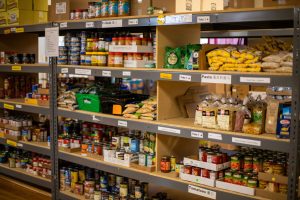Food Banks are trapped in a never-ending cycle of solicit, collect and distribute with no end in sight.
Sept 4, 2023
While the price of food in rises in our communities and monthly food bank visits are reaching new highs, national and provincial research shows that less than 30% of people facing some degree of food insecurity access food banks. The other 70% don’t. So, 1.3 million visits yearly across the country, hundreds of thousands of individuals in the province,1600 people served annually on the Sunshine Coast is but a sample. Despite being the most commonly used indicator of food insecurity, the true prevalence of hunger in our communities is much higher and cannot be measured by food banks visits alone.
Meanwhile, 70% of all government funding funnels to these institutions in the provincial and national fight against food insecurity. It’s true that annual gifts from the community and ongoing donations are crucial to the work of food banks in combatting immediate hunger. And quarterly food drives for cash or cans do replenish the shelves and backrooms of food banks and pantries– for a week, a month or a few months. But it’s time to acknowledge that this cycle and this model will continue unending until larger policy solutions are put in place- mainly enhanced income supports.
The poverty line for a family in BC, or two parents with two children is set at $47,950; for an individual it is $26,000 per year. Working at $16/hr full time for 50 weeks of the year, would leave an individual with around $28,000 before taxes. Food insecurity has little to do with employment status anymore. Many food bank clients list employment income as their main source. The reality is, income is just not keeping pace with the rising costs of living. It’s just not enough.

The Sunshine Coast food bank estimates that the value of a weekly hamper—a mix of fruit and vegetables, dairy, protein, staples, canned goods and bread—for a family of four would retail for about $89.00. So, looking at four times a month, with the occasional more expensive addition such as cereal, peanut butter or locally grown vegetables in season, the average monthly value is around $400. As such, the math indicates that if this family has $500 more a month in their bank account, they wouldn’t need to access the services and provisions from the food bank. One less family is a win for the food banking industry.
It’s time for ALL actors in the charitable food sector to expand their core business to include direct advocacy and shared calls for proven solutions to decreasing food insecurity- those solutions all revolve around putting more money in people’s pockets who need it through increasing income supports. Pandemic supports that prevented millions of Canadians from falling into deep poverty have now been retracted and gains in poverty reduction and food insecurity cannot be expected to be maintained.
With your help, food banks will continue to support those in our community on a weekly basis through our food bank and food hamper programs. But we cannot expect the calls for donations, the frequency of food drives, the asks at grocery tills, articles reporting increasing numbers and the ongoing needs of this food access model to decrease until policy solutions are deployed to tackle the root cause of food insecurity- poverty. The calls from food banks for more frequent, increasing and ongoing support is not because they are failing to end hunger. It’s because of unreal expectations and the responsibility of providing the “right to food” being passed from governments to the stretched and under-resourced not for profit or faith-based sector who are expected to carry out a what seems like a never-ending cycle of solicit, collect and distribute with no end in sight.
Dr. Chris Hergesheimer
Manager, Integrated Food Systems & Policy
One Straw Society
&
Lead Food Programmer, Sechelt Food Bank
Sunshine Coast Community Services Society



